- 現在位置
- トップ > 白書・統計・出版物 > 白書 > 文部科学白書(英文) > 2017年文部科学白書(英文) > Special Feature 2:Work Style Reform of Schools
Special Feature 2:Work Style Reform of Schools
Today, the environment surrounding schools is increasingly complex and diverse, and roles expected from schools are also expanding, which include response to problems of poverty and requests from guardians. Teaching reform to improve the quality of education and response to various education challenges are also demanded. In this context, it is an urgent issue to reduce workload on teachers in light of their work conditions. The Central Council for Education that is an advisory body of the Minister of Education, Culture, Sports, Science and Technology, started deliberation on " Comprehensive Measures for Work Style Reform of Schools ~Aiming to build a Sustainable System of School Guidance and School Management for Education in a New Era~" in June 2017 and compiled an interim report on December 22 of the same year. Based on the report, the ministry compiled emergency countermeasures and is working for work style reform of schools.
This special feature introduces work conditions of teachers, discussions on work style Reform of Schools at the Central Council for Education, and efforts by MEXT in Section 1; specific efforts by local governments in the following Section 2, and; future direction in Section 3.
Section 1 Work Conditions of Teachers and “Work Style Reform of Schools”
1.Preliminary results of the Survey of Teachers Working Conditions
MEXT launched the “demonstration study on educational policy” in FY2016. As part of the study, with the aim of grasping the working conditions of teachers of public elementary and junior-high schools, Survey of Teachers Working Conditions of 400 elementary schools and 400 junior-high schools (all full-time principals, vice principals, senior teachers, advanced skill teachers, teachers, lecturers, nursing teachers and diet and nutrition teachers of the schools) for seven consecutive days during the period from October to November 2016. Totaling (preliminary result) of the study was made public in April 2017. The Survey has been conducted for two years. Detailed analysis has been underway after the publication in April 2017.
According to the totaling (preliminary result) the total in-school working hours of teachers per week increased compared from the previous survey in FY2006 (Fig. 1-2-1).
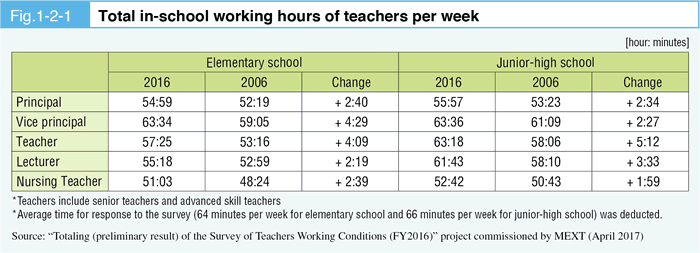
Looking at the distribution of the total in-school working hours, the largest ratio of elementary schools teachers fall in the 55 to 60 hours category. The largest ratio of junior-high teachers fall in the 60-65 hours category. The largest ratio of elementary school vice principals fall in the 60-65 hours category. The largest ratio of junior-high school vice principals fall in the 55-60 hours category (Fig. 1-2-2).
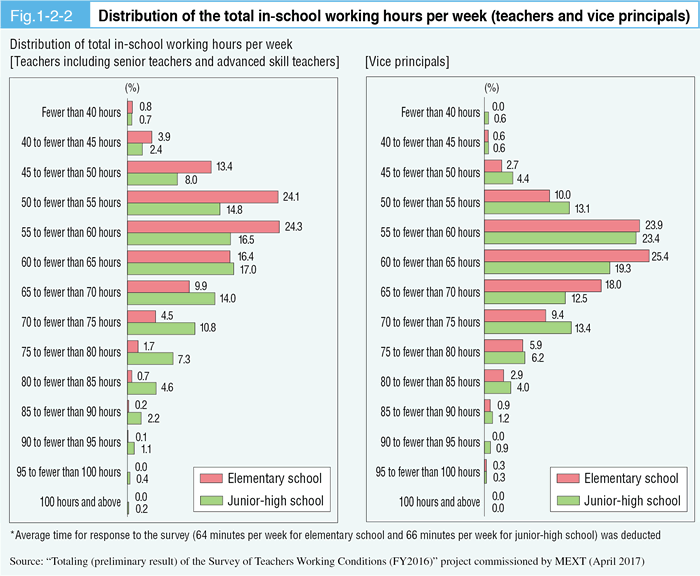
2.Study of “Work Style Reform of Schools”
(1) Background and significance of the study
With the aim of more surely fostering children’s competencies to live independently in the rapidly changing future society and participate in the formation of society, MEXT revised the National Curriculum Standards for elementary and upper secondary schools in March 2017. School education must certainly implement the new National Curriculum Standards and endeavor to improve and enhance school education. Especially teachers, who directly guide children, are required to realize “Curriculum Management*1” and to improve lessons from the perspective of “Proactive, Interactive and Authentic Learning*2.” Standard school hours will increase by 35 units per year for 3rd to 6th graders of elementary schools from FY2020 based on the new National Curriculum Standard.
Our schools and teachers have broader roles beyond educational guidance compared with other countries. Challenges facing schools in changing society and economy have become increasingly diverse and complex in recent years. These challenges include the increase of children/students who need special support due to guidance problems or disabilities, and children/students from foreign countries who need guidance to learn Japanese. In this context, we have no choice but to further expand the roles of schools.
Meanwhile, the expanded expectations for schools and teachers have already taken form as long working hours. The preliminary result of the Survey of Teachers Working Conditions (FY2016) revealed again the serious situation that cannot be ignored.
In order to maintain the merits of “Japanese-style school education”, steadily implement the new National Curriculum Standards and sustain and develop high-quality school education, reducing workload of teachers is a pressing issue.
In light of these matters, MEXT asked the Central Council for Education for consultation on “Comprehensive Measures for Work Style Reform of Schools ~Aiming to build a Sustainable System of School Guidance and School Management for Education in a New Era~" in June 2017.
The idea of the consultation is: review of the long working hours of teachers will provide opportunities for self-improvement of individual teachers through various experiences, which will lead to more effective activities, and in a working environment where teachers can maximize their motivation and ability, teachers will re-acknowledge that teaching is an “attractive job” and work with pride, which in turn will positively influence the education of the children.
*1 See Part 2 Chapter 4 Section 1, 1(4)
*2 See Part 2 Chapter 4 Section 1, 1(3)
(2) Deliberation at the Central Council for Education
The specific deliberation agenda of this consultation is the following three matters:
1.Work that schools should handle
- - What is the desirable way to do work that schools should continue to handle (including club activities)? What are desirable ways of division of roles among schools, families, communities, administrative bodies, etc., and what are the conditions required for promoting their cooperation and collaboration?
- - How to select documents that are required from schools based on relevant laws and regulations and various surveys regarding which administrative bodies, private groups, etc., request a response from schools?
2.Works that teachers, specialists and other personnel should each handle and role-sharing
- - What are the intrinsic works of teachers toward realization of the “School as a Team*3 ”
What are desirable methods of division of roles and collaboration of various specialist staff including clerical staff, school counselors, school social workers and club coaches and leaders *4 ? - - How to strengthen and enhance the system for educational and student guidance, which includes taking measures necessary for smooth and sure implementation of the new National Curriculum Standards in the context of the increase of the total school hours in elementary schools, for example.
- - What measures to take for further improvement of work that teachers and other personnel should do including effective use of ICT and for establishment of an effective system for the improvement?
3.Management system and working style of schools where teachers can concentrate more on teaching children with a sense of mission
- - What are desirable roles of vice principals, senior teachers and advanced skill teachers and desirable systems of organizational management of schools including clerical personnel who support school management? How should an effective school management system be built including change in the thinking of managers?
- - What measures should be taken toward streamlining and rationalization of the current division of duties in schools and various committees, etc. that are to be improved?
- - What are desirable working hour systems and management based on the school characteristics?
- - What should be the treatment based on the working conditions?
The Central Council for Education discussed the matters above at the Special Committee on Work Style Reform of Schools set up under the Subdivision on Primary and Secondary Education. The discussion used as reference the hearing survey of bodies concerned and experts conducted by MEXT prior to the consultation. At the special committee, members presented the recognition that teachers’ working conditions were an urgent situation that needs immediate improvements. As prompt response was required, the special committee recognized that it should make its recommendations as soon as possible so that all people involved in education share awareness of “do immediately what we can do now” and that each person can accelerate and ensure the efforts from his/her viewpoint. To this purpose, at the meeting held on August 29, 2017, the special committee compiled an urgent recommendation. This was followed by nine meetings with vigorous discussions during a short period up to the end of 2017. As a result, the “Interim Report” of the Central Council for Education was compiled on December 22.
*3 See Part 2 Chapter 4 Section 12, 2(3)
*4 See Part 2 Chapter 4 Section 12, 2(3)
(3)"Interim Report on Comprehensive Measures for Work Style Reform of Schools ~Aiming to build a Sustainable System of School Guidance and School Management for Education in a New Era~"
1.Basic approach to the Work Style Reform of Schools
According to the Interim Report, the aim of the Work Style Reform of Schools is to make qualitative changes in teachers’ work so that it will not harm their mental/physical health, secure enough time teachers can use for children/students and enrich the quality of daily living and teaching experience of teachers and thereby create an environment where teachers can enrich their lives and continuously provide comprehensive teaching that is truly necessary for children. The report also calls for attention to securing of the personnel in and outside the school who will take some of the roles that have been fulfilled by teachers.
During the discussion at the Central Council for Education the factors of extended working hours of teachers were pointed out from various perspectives. Based on the suggestions, study has been conducted from the viewpoints including (a) clarification and adjustment of the work conducted by schools and teachers, (b) review of the system of organizational management of school, (c) change in thinking about working hours and institutional considerations, and (d) work style reform based on the type of school and school provider.
2.Clarification and adjustment of the tasks conducted by school and teachers
The interim report recognizes: school work is broadly divided into educational guidance, student/career guidance, and class/school management, but affairs related to the above have been handled by teachers without definition of scope, and some of them have been carried out half as a matter of course. It recommends examination of such tasks from the two viewpoints of (1) ideally, who should do these tasks and (2) how to adjust them in order to reduce the burden, with the policy of actively transferring them to entities other than schools and teachers, while at the same time pursuing necessary environmental improvement.
In particular, the Interim Report presents approach to 14 typical types of work that have been conducted by schools/teachers (Fig. 1-2-3).
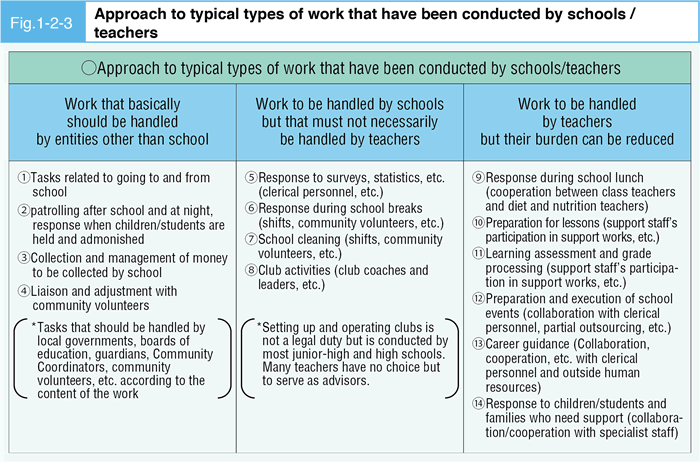
Most of the non-teaching work common to schools across the country may fall under the 14 categories above, but various other work may arise according to the situation of the school and the community, educational goals and curriculums of the school. Boards of education who are Service Discipline Supervisors are required to examine such work based on the work sorting above and with a policy to actively transfer them to outside of the school from the viewpoints of whether teachers can use their expertise in the work, and whether the work is related to lives and safety of children/students.
It is suggested that work that is not necessary but has been conducted conventionally should be abolished. It is important to reduce total workloads through division of roles and adjustment of work and by considering concrete reduction targets while making necessary environmental improvement.
In addition, the Interim Report developed measures that each of the state, boards of education and schools should take for consistent implementation of division of roles and adjustment of work. (Fig. 1-2-4).
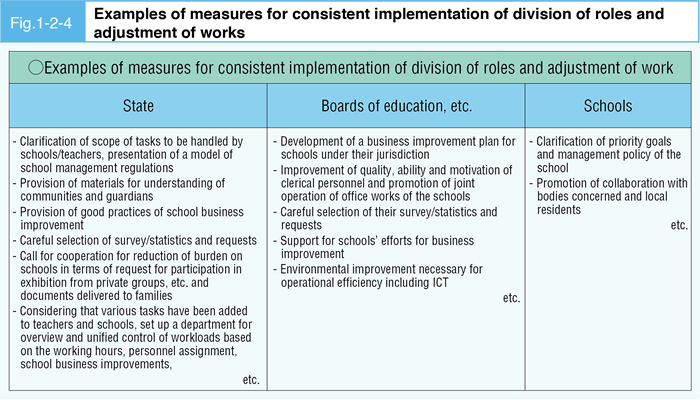
For adjustment of work, the report recommends integration of various plans developed by individual schools and unification/unified format of plans developed for individual children/students (teaching plan, support plan, etc.)
3.Desirable organizational management system of schools
For committees, etc. handling similar matters, the interim report suggested activities toward adjustment of affairs, which include joint establishment and unification of members of school committees. It was decided to continue discussion on the organization of committees, etc. that are truly effective for quality improvement of educational activities in school, the roles of persons in charge including coordinating and advising teachers, and the allocation of school work.
4.Reform of mindset and institutional consideration concerning working hours
MEXT has been calling on boards of education and others to be thorough with working hour management. The Interim Report, too, states that working hour management is a duty of principals and boards of education that are Service Discipline Supervisors based on the labor standard act system, and suggests that working hours should be monitored not based on self-declaration but by using ICT, time cards, etc. It also mentions that working hour management is “means” and not “ends” of work style reform and that formal monitoring of working hours should not become an end unto itself, leading to neglect of truly needed educational activities, and that keeping or having others keep false records must be avoided.
For setting appropriate working hours, it clearly stipulates again that the time of going to and from school should be set by considering regular working hours and break time for teachers and other personnel and that principals may not order overtime work other than so-called “four overtime items” including club activities and night patrol but should take measures such as appropriate allocation of regular working hours.
It also mentioned the importance of ingenuities to reduce inquiries from guardians by using answering machines in off-duty hours and school websites, appropriate setting of activity hours and non-club days based on the comprehensive guidelines on sports club activities, and by gaining the understanding of guardians and the communities concerning these efforts.
In addition, the report mentions changing in the thinking of teachers and other personnel about their working style taking advantage of training, personnel evaluation, etc. and checking/assessment of school business improvement linked to school evaluation.
The report indicated that in order to control overtime work of public school teachers, guidelines including the numerical upper limit of working hours should be considered and presented as soon as possible based on the discussions on work style reform in the entire government.
On the direction of the systems related to working hours of teachers and other personnel including the Act on Special Measures concerning Salaries and Other Conditions for Education Personnel of Public Compulsory Education Schools, etc., various opinions have been presented at the Special Committee on Reforming Work at Schools. It is found that it is necessary to continue discussions while considering the sustainable working environment in order to recognize the unique nature of teachers’ duties and guarantee the quality of learning for children/students.
3.Efforts by MEXT for Work Style Reform of Schools
(1)Urgent Measures for Work Style Reform of Schools
Based on the Interim Report of 2 above, MEXT compiled the matters to be addressed by the ministry in the Urgent Measures for Work Style Reform of Schools on December 26, 2017. The outline of the measures is as follows:
1.Measures for faithful implementation of division of roles and adjustment of work
- - Clarify standard duties of schools, teachers, clerical personnel, etc. and develop and present models to ensure their appropriate positioning in school management regulations of boards of education.
- - Collect and make public good examples of business improvement.
- - Widely ask for cooperation in reducing the burden on schools concerning requests for participation in various exhibitions, distribution of handouts, etc.
- - Establish an organization for overview and unified management of workloads of teachers and other personnel in the ministry. Addition of new tasks requires prior coordination with the organization in principle.
- - Improve the quality of school education through community schools*5, Community Cooperation Activities for Learning and Education*6 and other activities.
2.Review organizational operation including plans developed by schools
- - Encourage integration of plans of individual schools according to their content and current condition of the schools.
- - Encourage initiatives such as sharing by multiple teachers according to the content of teaching plan of individual subjects.
- - Present forms of necessary support plans in order to unify plans that have been developed for each child/student according to the condition of the school and the children/students for adjustment of works and effective teaching.
- - For committees, etc. handling similar matters, encourage activities toward adjustment of duties, which include joint committees and common members.
3.Measures necessary for change in thinking about working hours and control of overtime work
[Ensure thorough working-hour management and set appropriate working hours]
- - Ensure management of teachers’ working hours. Encourage construction of a system to objectively grasp and calculate working hours using time cards, etc.
- - Ensure time setting of going to/from school, club activities, school meetings, etc., with consideration of working hours and break time of teachers and other personnel.
- - In order to eliminate overtime work for response to inquiries from guardians and outside persons, encourage development of systems including communication using answering machines and e-mails, while at the same time securing contact methods in case of emergency.
- - Present guidelines for appropriate setting of club activity hours and non-club days.
- - Encourage setting of school-closed days for a certain period in order to secure annual paid leave during long vacations.
[Change in thinking of all teachers and other personnel about working hours]
- - Provide training for managers to develop management capacity. Encourage boards of education, etc. to provide necessary training on work style for teachers and other personnel.
- - Encourage implementation of personnel evaluation and school assessment from the viewpoint of school business improvement.
[Measures to control overtime work]
- - Develop and present guidelines including the numerical limit of working hours of teachers using as a reference The Action Plan for the Realization of Work Style Reform of the entire government.
On the desirable school organization and working hour system including the Act on Special Measures concerning Salaries and Other Conditions for Education Personnel of Public Compulsory Education Schools, etc., various opinions have been presented during the discussions at the special committee. The study will be continued.
4.Necessary environmental improvement
Expenses will be appropriated to the following initiatives for promotion of work style reform of schools.
- - Improvement in the staffing levels of teachers and other staff members, which includes expansion of teachers for a single subject in response to early English education and its introduction as a subject in elementary schools.
- - Utilization of specialists and outside human resources, which includes assignment of school support staff, school counselors, school social workers and club coaches and leaders.
- - Efficiency improvement and careful selection of services to be conducted by schools, which include practical studies for improvement of the efficiency of school business.
*5 See Part 2 Chapter 4 Section 15, 2
*6 See Part 2 Chapter 3 Section 3, 3
(2)Notice to boards of education, etc.
The Urgent Measures of (1) together with the request for intensive efforts for school business improvement and working hour management in schools was communicated to boards of education through the MEXT vice-ministerial notice*7 in February 2018 to call for efforts by individual boards of education, etc.
*7 “On development of urgent measures for work style Reform of Schools, and efforts for school business improvement and working hour management in schools” MEXT vice-ministerial notice on February 9, 2018)
Section 2 “Work Style Reform of Schools” by Local Governments
Work style Reform of Schools requires people involved in education to take necessary measures over the entire range of school affairs in their respective positions.
In order to further promote school business improvements, MEXT implements the “practical study project for acceleration of school business improvement” (“the practical study project”) by designating local governments focusing on school business improvement as a model area. The ministry is also transmitting and spreading successful examples through the “School Management Forum” and other occasions.
This section introduces commissioned practical studies and other advanced efforts for work style reform of schools by local governments.
1.Promotion of school business improvement
Leadership of the board of education is indispensable for school business improvement. Boards of education are required to develop school business improvement policy and plans for schools with a strong sense of crisis and steadily promote school business improvement together with school staffs.
Column No.03 Efforts by Okayama Prefectural Board of Education (Written by the Okayama Prefectural Board of Education)
In recent years, the environment surrounding schools has become increasingly diverse and complex, the role of schools has been expanding and burden on teachers and other personnel is increasing. In the future, it is anticipated that full-scale implementation of the new National Curriculum Standard and response to the university entrance examination reform will require even more time. In addition, the number of teacher candidates is decreasing as students are less willing to take a teaching job. The Okayama Prefectural Board of Education is working on work style reform with a strong feeling that “this is the last chance to tackle the issue”.
1.Analysis of the FY2016 Working Condition Survey (conducted by Okayama Prefectural Board of Education)
The Working Condition Survey (survey of working hours per week by age group and duties by choosing about 10% from each school type) conducted by the Okayama Prefectural Board of Education in June 2016 revealed the following.

Compared with past survey results, overtime work has been increasing year by year in every type of school. In junior-high schools, in particular, more than half of the teachers of the surveyed schools worked overtime exceeding 80 hours per month.
By age group, the overtime of young teachers in their 20s is the longest for all school types. It is found that elementary school teachers spend the most time in school for preparation for lessons.
2.Work style reform plan*8
In response to the result of the FY2016 Working Condition Survey, the board set up a work style reform promotion committee consisting of the representatives of the principals’ association and municipal heads of education and heads of the relevant departments of the Agency for Education of the prefecture. The committee in cooperation with municipal (association) boards of education formulated a work style reform plan as an action plan for reducing overtime work of teachers and other personnel. For the formulation the board spent considerable time discussing the approach to overtime reduction targets and non-club days, ways to gain understanding of guardians and the community and other matters. The work style reform plan has the following four priorities:
- Thorough time management
- Reduction of clerical affairs
- Support for lesson preparation
- Ensure non-club days
Designated as a practical study project of MEXT, Kasaoka Municipal Oi Elementary School, Takahashi Municipal Takahashi Elementary School and Asakuchi Municipal Kamogata-higashi Elementary School appointed teachers who take a central role in understanding of actual conditions and careful selection of work and planning/operation of in-school training. The schools also worked on study for reform of thinking of teachers and other personnel as well as improvement of work efficiency, while receiving regular guidance and advice from outside consultants.
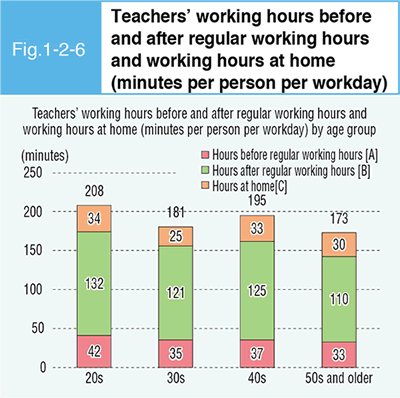
*8 See http://www.pref.okayama.jp/page/519079.html
3.Achievements of the activity
The activities in FY2017 produced the following three results:
(a)Practice of time-conscious working
The latest quitting time (the time when the last teacher/other personnel leave the school. The board indicates 20:00 as a guide) and the day for leaving work on time (day without meetings, training or club activities after school for prompt leaving of school after regular working hours) are provided in about 70% of the schools though with some difference depending on the school type (as of October 2017 based on a survey of the principals of all public schools excluding Okayama city). School closed days (set by the board for the period from August 13 to 15, where teachers and other personnel do not attend work throughout the day or no duty person is appointed in principle. Teachers and other personnel take summer special leave, annual leave, etc., and transfer weekly holidays) during summer vacation were implemented in all public schools of the prefecture.
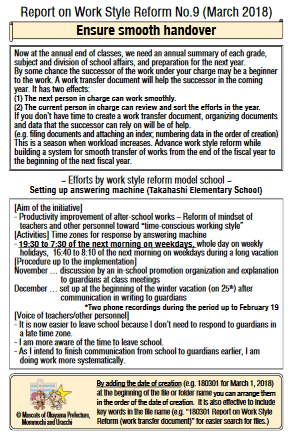
Report on Work Style Reform (March 2018)
(b)Setting non-club days
Since September 2017 junior-high schools have two or more non-club days per week. High schools have one or more non-club days per week. All junior-high, high and secondary education schools are working on this issue.
(c)Spreading the initiative of the model schools of the practical study project (model schools) across the prefecture
Lectures on the need for work style reform are provided for managers by outside consultants. Efforts were made to spread business improvement activities in model schools through the “Report on Work Style Reform” issued by the prefectural Agency for Education every month. These efforts encouraged other schools to do similar activities and promoted reform of thinking of teachers and other personnel and independent activities of schools.
Activities of the model schools are as follows:
- System development by study promotion organizations
Model schools have set up a study promotion organization for school business improvement. The organization has been discussing implementation plans and challenges after the implementation at regular meetings. In addition to teachers and other personnel, school counselors and PTA committee members joined the organization. The schools can speedily implement school business improvement while hearing opinions of the representatives of guardians and the community.
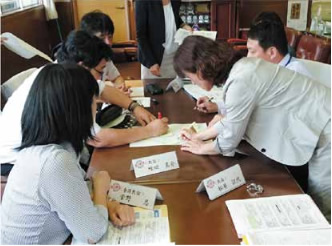
Making improvement suggestions using sticky notes (Takahashi Elementary School, Takahashi city) - Study procedure
School Business improvement was studied at the model schools in the following procedure:

First, we shared thoughts of individual teachers and other personnel on ideal school and work styles through questionnaire surveys, etc. Based on their diverse values and thoughts, the study promotion organization discussed the purpose of work style reform pursued by the school.
“Work style reform of teachers and other personnel is not limited to time savings!” this is the idea common to all three schools. Through lectures and advice by consultants the teachers and other personnel could understand that their efficient working and securing of time for health maintenance, reading and other private activities would contribute to the improvement of the quality of education.
For careful selection of work, it is necessary to know what work the school is doing (identification of works). Some work is done simply because it has been done. Some has no clear purpose. Other work places a mental burden on specific people or departments or unreasonably takes their time. Ideally these operations should be eliminated but reviewing the implementation method and reducing the number of times to do them can also reduce the burden.
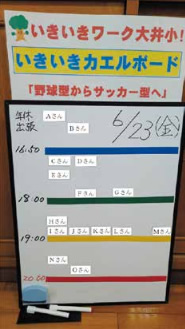
Photo: Ikiki Kaeru Board(Oi Elementary School, Kasaoka City) - Activity examples
Let us introduce effective activities of the model schools.- (a)Time-conscious working style
Aim … Efficient execution of work keeping in mind the time to leave the school… Name tags of individuals are arranged on the Kaeru Board (go-home board for self-reporting of the time to leave the school) in the teachers’ room according to their scheduled time to leave. Talking to the coworkers who are still in school after the scheduled time
Voice of teachers/other personnel … I can set the coworkers’ time to leave as my goal.
Result … Raised awareness of time and priorities of works, revitalized communication - (b)Careful selection of works
Aim … Every year, swimming practice after school from June to July toward a district swimming event for recording time during summer vacation was one of the causes of long working hours for teachers. To address this problem we discussed ways to do away with swimming practice after school so that teachers and other personnel can use after-school hours effectively … instruction in regular classes, enhancement of instruction during summer vacation
Voice of teachers/other personnel … I tried to be creative with PE lessons to change the thinking of children while pursuing efficient instruction.
Effect … Reduced burden on teachers (they could use after-school hours for preparing for lessons, etc.) (*the number of children attending the swimming event increased by 2.5 times compared with the previous year.) - (c)Improvement of workplace environment
Aim … improvement of the functionality of the teachers’ room, revitalization of communication among teachers and other personnel
Method … Setting Work, Consulting and Rest Zones; transparent stationary cabinet; Cafe Space; layout change of the teachers’ room based on the advice of a private enterprise

Teachers’ room before and after the change (red circle indicates the seat of a manager) (Kamokata-higashi Elementary School, Asakuchi City)
Before the change: some seats are far away from the manager seat. A copier and a printer are in a corner.
After the change: distance between each grade group and the manager was made even. The printer was placed at the center of the room. - (a)Time-conscious working style
- Results of the activities
Through repeated trial and error we could accumulate small successful experiences and grow in self-confidence. Gradually teachers and other personnel started to bring various improvement ideas and an atmosphere to pursue and enjoy work style reform has been established.
As we discussed improvement measures together with representatives of guardians and the community, it is now easier to gain their understanding of and cooperation with the activities of the school. The activities changed how teachers and other personnel think about work style and time, and the long overtime hours are decreasing little by little.
2.Working hour management
Working hour management is a duty of principals and boards of education that are Service Discipline Supervisors based on the labor standards act system. Knowing working hours is also essential as a basis for school business improvement. For this purpose, boards of education, etc. need to endeavor to promptly build a system to objectively grasp and tally working hours using ICT, time cards, etc. Working hour management is a “means” and not and “end” of work style reform. In addition to ensuring grasp of working hours, boards of education are required to analyze the result and encourage schools to make necessary efforts.
Column No.04 Activities of the Kitakyushu City Board of Education, Fukuoka Prefecture (Written by the Kitakyushu City Board of Education, Fukuoka Prefecture)
In April 2012 the board introduced a school work support system that can handle performance management, document management, etc. In January 2013 we added service management functions including work starting/ending time management and are advancing digitalization and sharing of school work information in order to improve the efficiency of office processing and reduce the office work burden.
Work starting/ending time is registered when teachers and other personnel hang their personal IC card over a card reader (lower left photo) or click the attendance/leaving registering screen (lower right photo) of their personal computer for business use.
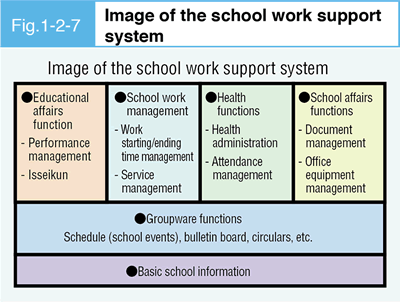
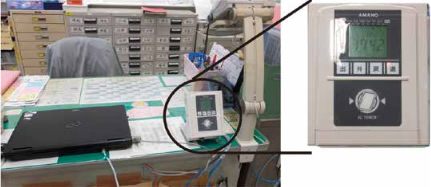
Card reader
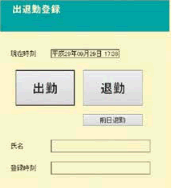
Attendance/leaving registering screen
Shortly after the introduction of the system it was difficult to know correct working hours because some personnel forgot to register and others did not register when they came to work on Saturday or Sunday for club activities, etc., but we regularly communicated how to use the system as best we could.
As a result, the principal has come to know the work condition of each staff member and easily identify personnel who are candidates for face-to-face guidance by an industrial doctor based on the Industrial Safety and Health Act.
The Board of Education can also grasp work starting/ending time of all personnel and extract and analyze information of each school, job and individual. The results can be used for understanding school conditions, health management of personnel, verification of business improvement effects and other purposes.
Specifically, the board provided school principals with information of average hours in school (hours obtained by deducting working hours from the hours from the work starting time to the ending time) per month of each of all schools in the city to encourage efforts for school business improvement. We also conducted a hearing survey of schools with a big change in hours in school compared to the previous year to gather information concerning effective activities.
We can also acquire information of individual personnel, which is indispensable for health management. We grasp the situation of personnel with consistently long hours in school through the principal and recommend them to receive face-to-face guidance of an industrial doctor.
Working hour management is not only a duty to be fulfilled based on the labor standards act system, but is also activities contributing to promotion of work-life-balance by principals and motivation for school business improvement. We think it is also necessary for a board of education to create an environment where teachers and other personnel can work with motivation while securing time to face children.
3.School Business Improvement through Functional Enhancement of School Administration
According to the Survey of Teachers Working Conditions conducted by MEXT in April 2017, working hours of vice principals are longer than those of principals and teachers. In particular, they engage in office works for longer hours.
In order to reduce office work burden on busy vice principals so that they can fulfill their management function in school, clerical employees of school are required to participate in school work more actively.
However, an elementary/junior-high school employs only one office worker in average.
School administrators are expected to play a part in school management in cooperation with school managers, teachers and other personnel, while improving efficiency of their existing work through introduction of a general-affairs system and joint implementation of office work, for example.
Column No.05 Activities of The Gosen City Board of Education, Niigata Prefecture(Written by The Gosen City Board of Education)
Gosen City (Niigata) set up a business improvement promotion committee consisting of responsible persons and teachers’ consultants of the board of education, managers of schools and office workers under the Head of Education and is promoting business improvement in collaboration with the board of education, schools and an organization for joint implementation of school administration.
Functions of school administration have been enhanced based on joint implementation.
In this initiative, the elementary and junior-high schools in the district are divided into three groups, the head of each group visits schools of the group and provides guidance and advice to office workers according to the circumstances of the school in an effort to standardize and improve the quality of office work. Efficiency of office works is improved through activities such as visualizing the process of office work relating to accounting, school register, textbooks and other matters and eliminating overlapping work; development of a system for management of number of hours corresponding to the new National Curriculum Standard, and; digitalization of attendance books.
Through improvement of office work efficiency, we are encouraging office workers to participate in school management more actively, which may include taking part in the operation of a school diary system that records services, business trips, etc. of teachers and other personnel, which is handled by the vice principal, and operating the budget committee and the teaching material selection committee, for example.
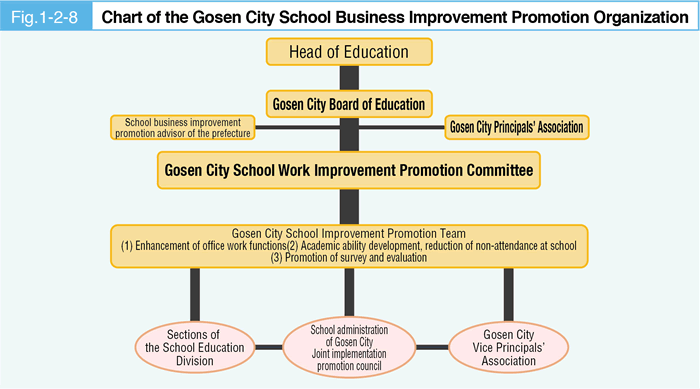
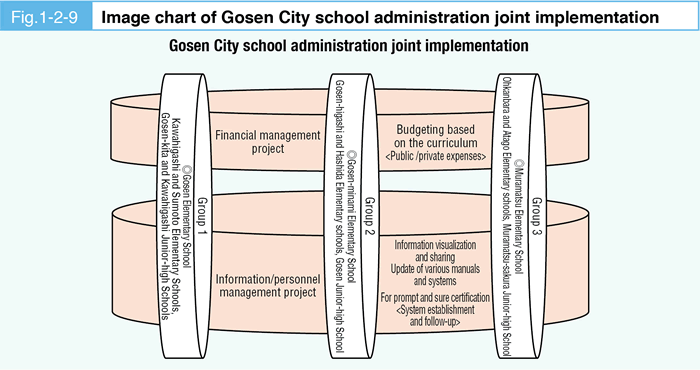
4.Reduce Office Work Burden on Teachers (Participation of School Support Staff)
In order to reduce the office work burden on teachers and develop a system where they can focus more on teaching children/students and study of teaching materials, it is effective to introduce support staffs who take teachers’ place in printing learning prints, checking submission of homework, etc., marking simple Chinese character/calculation drills and other similar works.
Column No.06 Activities of Chiba Prefecture Board of Education (written by Chiba Prefecture Board of Education)
In order to reduce hours in school exceeding regular working hours and ensure time for teachers to face children, Chiba Prefecture Board of Education assigned “Elementary School Class Administrative Assistants” to all 20 elementary schools of Noda City that is designated for the practical study project of MEXT. The assistants assist clerical work that is handled by class teachers of elemental schools.
1.Effects of the assignment of Elementary School Class Administrative Assistants
As about 70% of class teachers answered “office work is reduced”, it is inferred that assignment of Elementary School Class Administrative Assistants generally contributed to reduction of the workload.
Works commissioned to Class Administrative Assistants that were effective to reduce workload include material printing, simple marking, electronic input of attendance books and money collection. Effects varied depending on the scale of the school. Small schools more often asked for in-class work such as simple marking and money collection, whereas larger schools more often asked for work across the entire grade such as material printing and assistance for teaching material creation. For the future we will work to improve the quality and efficiency of requests by increasing mutual understanding between teachers and class administrative assistants through close information exchange between them.
2.Office workload of class teachers
A day’s work of two class teachers with different years of experience was measured with the following result:
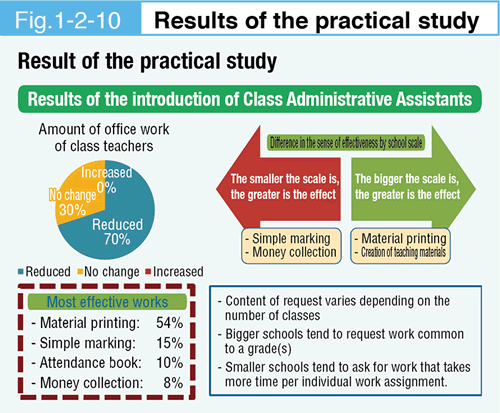
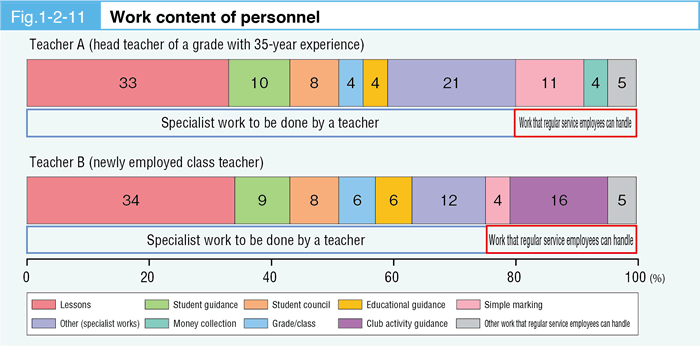
In the example above, about 20% of the work including simple marking, club activity guidance, money collection and printing/distribution can be handled by personnel (including Class Administrative Assistants) other than class teachers. In the future we will make the example known to individual schools and work to further reduce burden by requesting Class Administrative Assistants for help while encouraging each staff member to review their work.
Column No.07 Efforts of Okayama Prefecture Board of Education (written by the Okayama Prefecture Board of Education)
In order to reduce the burden of office and other works handled by teachers so that they can focus on education activities, since FY2015 the Okayama Prefecture Board of Education has been assigning local human resources as Teacher Administrative Assistants (“Assistant”) to schools.
Teacher Administrative Assistants are assigned as follows:

1.Assignment criteria
The assignment was made as a model project up to FY2016. The following assignment criteria were formulated based on the results of the two-year model project.

2.Affairs under charge
Preparation for lessons (e.g. printing, preparation of ICT equipment); material creation/printing, accounting work for class, grade, club activities, PTA, etc.; improvement of classroom environment; creation/posting of notices; survey/statistics/data entry, etc.
3.Effects of the assignment
Schools where the assistants are assigned saw increasing number of teachers who could secure time for their original job including teaching material study and home learning (homework) guidance. About 93% of teachers of the schools where assistants were assigned in FY2017 answered “asking the assistant to do some tasks was effective for reducing my workload.”
We are doing the following activities for effective use of assistants:
- Preparation and distribution of a manual (March 2017)
The manual includes the flow of assistant’s work, points of attention and advice from senior assistants. Daily service starts from receiving instructions on the work content in the morning, assistants are expected to do tasks according to their priority and record their content in the assistant diary at the end of the service. Some of the key advice is: “ask freely when you don’t understand,” “demonstrate your strengths” and “be proactive in communication to build a human relationship that will encourage people to ask for your help.” - Need for management
Schools where an assistant is assigned need to assign a teacher or other personnel for management. His/her role is to adjust the workload of the assistant, set priorities and build an in-school system to effectively give work to the assistant. Specifically, the manager can use request slips to enter the content of requests from teachers and visualize the workload of the assistant on a white board. An environment that encourages teachers to ask the assistant for help includes placing the seat of the assistant in the movement lane of teachers or next to a clerical worker, and securing his/her workspace.
5.Reducing Burden of Club Activities.
Setting up and operating clubs is not a legal duty of schools, but most junior-high and high schools have clubs and many teachers have no choice but to serve as advisor. Some teachers feel satisfied with club activities, but some teachers who lack athletic experience and skills necessary for guidance in club activities are feeling the burden of serving as advisor. According to the Survey of Teachers Working Conditions (FY2016) made public in April 2017, hours used for “club activities” on Saturdays and Sundays almost doubled from a decade ago (from one hour and six minutes to two hours and 10 minutes).
In this context, it is strongly desired to reduce the burden of club activities on teachers. Means to this purpose may include participation of outside human resources such as club coaches and leaders. In March 2018 Japan Sports Agency formulated comprehensive guidelines on sports club activities to ensure diverse and optimal implementation of sports club activities in accordance with the circumstances of the region and the school and with the principle of creating a sustainable sports environment that is desirable for students. Local governments are required to formulate their policy on sports club activities that provides activity hours, rest days and other appropriate matters concerning sports club activities.
Column No.08 Efforts of Shizuoka City Board of Education(Written by Shizuoka City Board of Education)
[Reform of club activities of Shizuoka municipal junior-high schools - introduction of licensed advisors]
Inspired by the Shizuoka city education conference that took up “Reduce pressure of work on teachers” in FY2015 and FY2016, Shizuoka City Board of Education accelerated its discussion on club activities. According to a survey on club activities conducted by the city in August 2016, the top factor of overwork in junior-high schools was club activities, 55.3% of club activity advisors were without athletic experience, 50.8% of teachers were not confident in club activity guidance, and 51.3% of teachers could not get enough rest on Saturdays and Sundays. The survey revealed that about half of teachers have some problems.
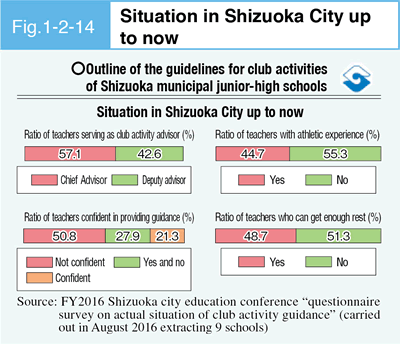
1.Preparation and publication of the guidelines for club activities of Shizuoka municipal junior-high schools
Up to now club activities in the city have been operated under a relaxed rule called “an agreed item” of the Principals’ Association. In order to define the desirable state of club activities and make them meaningful for both students and teachers, the board decided to prepare the guidelines for club activities of Shizuoka municipal junior-high schools (“the guidelines”).
By voluntarily formulating the guidelines, the board of education aimed to ensure “proper rest” in club activities of junior-high schools across the city, prompt well-balanced growth of students, promote effective and efficient guidance in limited time and connect the initiative to the “Work Style Reform” in FY2017. For preparation of the guidelines the board organized a club activity council consisting of the Principals’ Association, the Junior High School Physical Culture Association, the Junior High School Culture Association, PTAs, Shizuoka City Sports Association, experts and other members. The council solicited a broad range of opinions of citizens through public comments. We received a large variety of opinions ranging from “club activities should be done every day to strengthen students” to “because overheating is a problem, penal regulations should be introduced” We adjusted the differences of these opinions and worked with a sense of urgency. As a result, the guidelines were formulated at the board of education on February 1, 2018, about one year after starting detailed study.
2.Desirable club activity days
The guidelines present the meaning and purpose of club activities, coaches/leaders to achieve them, activity days, organization, methods of guidance, safety-related and other matters in a comprehensive manner. Major pillars of the guidelines are rules on activity days and utilization of outside coaches/leaders. First, club activity days should be four days including three week days and one day on Saturday or Sunday. There are six annual “days without club activities” consisting of three days common across the city, which include the day for disaster prevention activities of the city, and three days decided according to the actual condition of the school. By clearly setting activity days, we tried to make students engage in club activities while getting proper rest and also engaging in various activities including community activities.
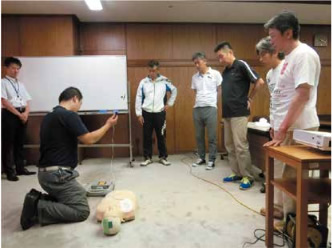
Workshop for outside advisors
3.Introduction of licensed advisors
For utilization of outside human resources we have introduced licensed advisors (outside instructors whom the board of education qualified (licensed) for independent coaching/leading) in addition to outside instructors who assist teachers in technical guidance. The purpose of introducing the license system is not simply to employ outside instructors but to secure better human resources for schools by qualifying the outside instructors after providing them in-depth training including the educational meaning of club activities in school.
Before giving licenses we provide training (lectures and practice) for improvement of quality by inviting lecturers from the board of education, universities in the city, Shimizu S-pulse of J League, the Fire Department, etc. The training consists of 5 hours on school education, 2 hours on instruction of the sport, tests and reports. This is followed by one-month hands-on training. Finally, we conduct an extensive interview and assign the candidates whom we find to be the right persons to be instructor as licensed advisors at schools. In FY2017 we assigned 5 licensed advisors to model schools and analyzed the effects and challenges.
In FY2018 we will increase the number of licensed advisors. We will also employ as outside advisor one top athlete recommended by the National Olympic Committee of the country, government organs, etc. as Sports Exchange Advisor and start development of effective and efficient instruction methods (Shizuoka Model).
Understanding of guardians and people of the community is indispensable for operation of the guidelines including outside advisors and activity days. To this end, we will conduct a broad range of publicity activities including distribution of easy-to-understand leaflets on the club activity reform, development of a website on club activities of Shizuoka municipal junior-high schools and setting up of a contact related to the club activity reform.
4.Formation of Shizuoka City Club Activity Supporters
In order to accelerate efforts for club activity reform, we are forming the Shizuoka City Club Activity Supporters in collaboration with private companies and offices of the region (development of a system to support club activities). Companies participating as Club Activity Supporters are expected to post the Manifesto of Shizuoka City Club Activity Supporters and back up club activities in various ways including introduction of candidates for club coaches and leaders and lectures for workshops, and production of club activity goods.
We also asked sports associations for cooperation to gather information on regional sports activities, which will include soccer schools, athletics schools and other opportunities for students who wish to further play sports outside club activities and students who wish to improve their game technique. The information will be published on the city website. In this way we will create a system for the entire city to support club activities including private companies and community sports clubs.
5.Kick off of work style reform starting from club activity reform
The guidelines were just formulated in February 2018. Model schools where licensed advisors were assigned before the implantation of the guidelines are already seeing its effects. For example, hours related to club activity guidance are reduced in clubs where licensed advisors are assigned. ”Hours required for club activities” have been reduced by 8.0% on average compared with other club activities, and monthly average hours required for club activities on weekends also decreased by 27.2%. Advisors (teachers) of the clubs with licensed advisors voiced: “I feel the technical and mental growth of students” and “now I have more time to spend with my family.” Students are delighted with the improved quality of activities: “I can enjoy innovative training menus” and guardians say “I appreciate careful instruction from the basics.” We are steadily getting results.
The Kickoff of Club activity reform of Shizuoka City has just started. We will work toward the goal that is an environment where children can vigorously engage in well-balanced club activities and where we can provide each child with efficient and effective instruction.
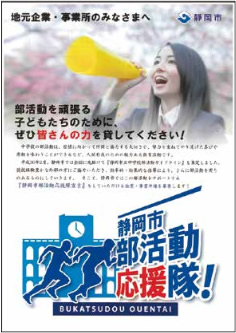
Leaflet of Shizuoka City Club Activity Supporters
Column No.09 Efforts of Tajimi City Board of Education, Gifu Prefecture(Written by Tajimi City Board of Education)
In response to a string of club disbandment due to the declining birthrate and full implementation of a five-day school week, since FY 2003 Tajimi City has been implementing sports and cultural activities of junior-high school students through two club activity systems: one under the management of the school and the other is a Junior Club set up by guardians.
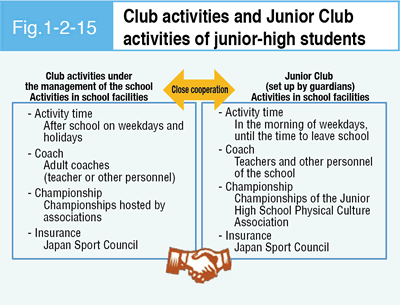
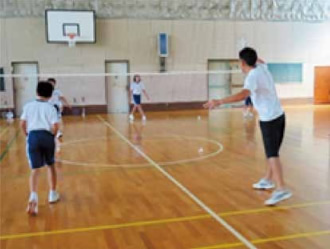
Activities of Junior Club
Junior Club activities with cooperation of guardians have achieved a big result in “strengthening of game technique through improvement of the training environment,” “club activities meeting the needs of children” and “deepened guardian’s understanding of the activities.” However, there are also difficulties for the guardian organization to support activities that are aimed at enhancement of game technique, in terms of “development of instructors,” “understanding of the benefit principle,” “negative effects of excessive activities” and “common understanding of the purpose of the activities” for example. In response we have compiled considerations for development of the sports environment for healthy development of elementary and junior-high school students as “guidelines for sports activities of juniors.” The guidelines include desirable activity hours and quality of instructors and consideration for safety.
In February 2018 in Tajimi City, Gifu Prefecture, the Furusato Round Table Talk*9 was held with participation of the State Minister of Education, Culture, Sports, Science and Technology Niwa, school officials, guardians and others to discuss work style reform in school. At the roundtable people involved in launching Junior Club activities said: “we cannot expect much from the traditional club activity system alone because many clubs are disbanded and there are not enough members to form a team due to the declining birthrate. Junior Club activities, on the other hand, have many positive aspects including opportunities for children to interact with guardians and the community. There are possibilities to enhance the activities for children.” Guardians said “the level of the technical instruction of Junior Club is high and children progress quickly, but guardians are talking about the burden of Junior Club including taking children to and from the club. We at the PTA will work hard to communicate the meaning and good aspects of the club to guardians.” From junior-high school teachers: “thanks to Junior Club activities, we can use the time for response to guardians, preparation for lessons and necessary meetings.”
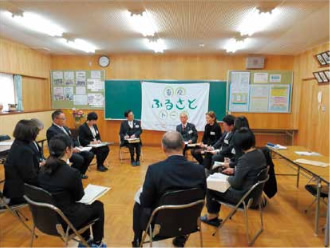
Furusato Roundtable Talk
*9 Furusato Round Table Talk: Ministers, Senior Vice-Ministers and Parliamentary Secretaries of the Abe Cabinet will visit regions to hold round table talks on specific themes with a small number of local people, carefully listen to their frank opinions, reflect them in policies and explain key policies.
Column No.10 School business improvement advisor
In order to provide precise advice and support for school business improvement, since FY2017 MEXT has been requesting 21 experts, educators and others with knowledge in school business improvement to work as school business improvement advisors, and dispatching them at the request of boards of education, etc.
Here we introduce messages from the advisors to teachers concerning work style reform of schools.
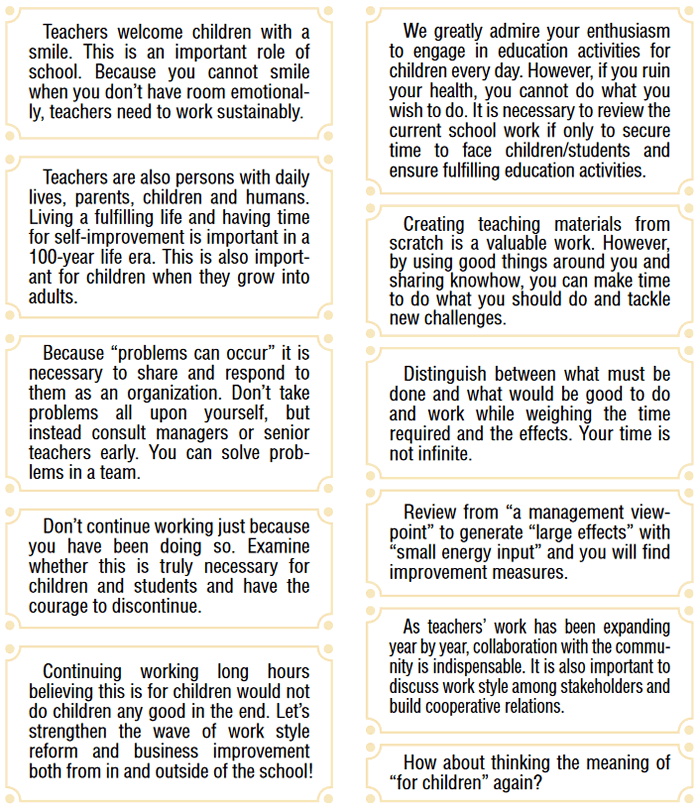
Section 3 For the Future
MEXT will increase efforts for “Work Style Reform of Schools” by reviewing long working hours of teachers so that each teacher has opportunities for self-improvement through various experiences, which will lead to more effective education activities.
For this purpose, as described in Section 1 the ministry will take various actions included in the Urgent Measures including setting up of a department for overview and unified control of workloads of teachers and other personnel, consideration of guidelines that include the numerical upper limit of working hours, and various publicly financed projects.
In order to further create good examples of school business improvement mentioned in Section 2 of this special feature for further promotion of school business improvement, MEXT will also implement “Practical study project for acceleration of school business improvement” by designating local governments focusing on school business improvement as model areas. The ministry will also communicate and spread good examples to the entire nation through implementation of “School Management Forum”.
In addition, MEXT will consider necessary measures for organizational management system of schools and institutional measures to control overtime work based on the discussions on “Work Style Reform of Schools” at the Central Council for Education.
Based on the above it is expected that boards of education and schools will further promote efforts for school business improvement and working hour control in schools to realize truly high quality education activities.
お問合せ先
Education Policy Bureau Policy Division
-- 登録:令和元年06月 --